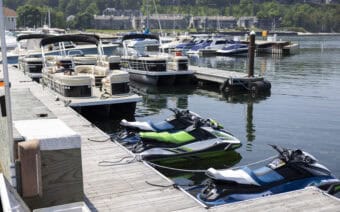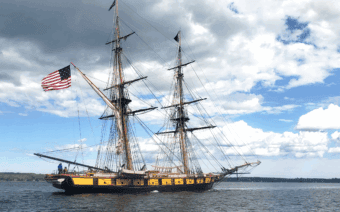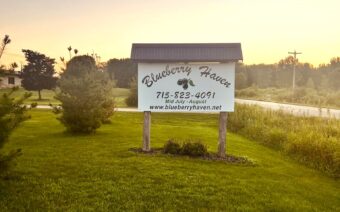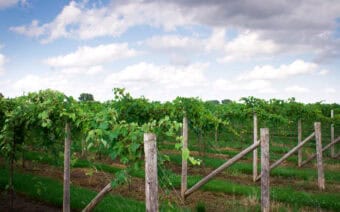
May 1, 2024
OSHKOSH – It began in 1985 as a morale booster during one of the Oshkosh area’s worst recessions to that point and a means to create a more positive image of the city and its natural resources.
Today, Waterfest is about to embark on its 38th season – (it’s actually its 39th year, but the event didn’t happen during the COVID-19 pandemic).
A look back
Mike Dempsey, president of Waterfest, Inc. (Waterfest Concert Series), said between 1980-84, the Midwest, including Wisconsin, was feeling the brunt of the recession.
The prime interest rate was 21% and unemployment topped 14%.
During that time, Dempsey said it became clear to local government and business leaders something needed to be done to accentuate the positives about Oshkosh – one of which is the waterfront.
“Oshkosh is unique because we have lakes on two sides of the city, and we’ve got the riverfront running through it,” he said. “One of the greatest assets we have is our waterfront and water-related activities with our natural resources. The idea was to boost the morale in the community by creating a significant sense of community and reminding people about what goes on here.”
So, in 1985, the Waterfest idea – then dubbed “Wisconsin’s Largest Free Music Festival” – was born, with city leaders, the Oshkosh Chamber of Commerce, Chamco and others in the business community agreeing to underwrite the event.
In the summer of 1986, the first Waterfest was held, with such national acts as The Association, Freddie Fender and the Booze Brothers.
Three phases of Waterfest
Looking at how Waterfest became what it is today, Dempsey said, can be separated into three phases.
Phase 1: For its first three years, Waterfest was held at the Fox Valley Technical College’s Skill Center located in Oshkosh on the Fox River, by the Wisconsin Street/Ohio Street bridge.
As season three came to an end in 1988, Dempsey said the chamber ended its sponsorship of the event, despite the event performing well.
Phase 2: In 1989, the Oshkosh Jaycees stepped up and agreed to take over Waterfest, moving the event to a different location – Riverside Park, still on the Fox River, but next to the city’s new hotel and convention center.
Along with a new location, Dempsey said Waterfest also added other events – including a comedy film festival, carnival, waterski and laser light shows.
Some additional locations were utilized for these other events, including a city parking lot and the Grand Opera House.
“By moving it to Riverside Park next to the new hotel and convention center, it was an anchor for economic commitment to revitalizing the riverfront and the downtown area,” he said. “It remained a weekend festival for another three years in that location. We worked with several tents and portable stages and used not only the convention center but the Grand Opera House, which had also recently been remodeled.”
In 1992 the Jaycees ended their four-year commitment.
Simultaneously, Dempsey said, Waterfest changed from a weekend event to a weekday concert series held every Thursday night throughout the summer.
“The benefits of that at the time were we wouldn’t burn out our service groups that were handling the concessions and helping put on the show,” he said. “We could sprinkle that throughout the summer on a Thursday evening.”

Mike Dempsey said the Leach Amphitheater helped the event attract larger shows, like Alice Cooper because it provided the infrastructure they needed. Submitted Photo
The Thursday night slot, Dempsey said, also freed up people’s weekends.
“And it was easier to get good volunteer help on a weekday,” he said. “Our fan base didn’t have to choose one or two nights to go to Waterfest. They could choose any number, even 10 or a dozen nights.”
Having a weekday concert series, Dempsey said, also helped economically because they could book touring bands on an off-night when they generally had their major shows on Fridays and Saturdays.
“We might be able to pick them up en route (to a show) on a Thursday versus on a weekend,” he said. “So, it seemed to work for us in all those regards.”
Dempsey said it also helped diversify weather risk.
“If we got washed out on a weekend, it would kill everything,” he said. “What we were able to do is figure out how to run a budget with eight or 12 evenings and make it work even if one or two of the shows were weather-impaired.”
Phase 3: The third phase started, Dempsey said, when Waterfest moved to the newly-built Leach Amphitheater, which broke ground in 2004 and had the first acts – including Pat Benatar and Three Dog Night – play there in 2005.
“The amphitheater assisted us in producing larger shows, such as Alice Cooper and some of the larger touring acts because they needed a permanent structure that was somewhat weather-resistant,” he said. “It also assisted in providing the infrastructure for larger sound and light requirements.”
From brownfield to Waterfest home
The 7.6-acre site on which the Leach Amphitheater sits, Dempsey said, was once highly industrial.
Wisconsin Public Service (WPS) Corp. owned and operated a gas plant on the property from 1869 to 1946.
Some of the plant’s processes included coal carbonization and carbureted water gas.
When WPS stopped production and moved from that site, Dempsey said the property sat there, unused for decades.
Any buyer would have had to have the now-contaminated land remediated for any future use, so it generated little to no interest from potential buyers.
As with getting Waterfest off the ground, Dempsey said it again took a public-private partnership to turn this brownfield redevelopment site into what would subsequently become the new home of Waterfest.
In November 2003, through efforts of the Oshkosh Area Community Foundation, Winnebago County and the City of Oshkosh, Dempsey said the city purchased the riverfront land from WPS for a public park and amphitheater.
Sixteen days later, the Leach family announced a major gift to the city to fund the venue, hence its name.
Dempsey said the Upper Fox River borders the site to the south with Lake Winnebago about two-tenths of a mile downstream.
Since 2003, the site has been owned by the City of Oshkosh and was redeveloped into a public park, which includes the amphitheater and a new riverwalk on both sides of the river.
Boat docking along the shoreline, Dempsey said, enables boaters to visit the park.
The park also became the permanent home for Waterfest – which opened its 20th season at Leach Amphitheater May 26, 2005.
Growth, community contributions
Dempsey said sometimes when a public-private partnership’s intention is to develop an otherwise empty site, it can be hard to generate interest from investors or gain their confidence in investing in something they can’t see.
“Looking at the Leach Amphitheater and what it did (shows) how quickly you can reinvent the perception and the environment with a little bit of investment and elbow grease,” he said.
In the early days of Waterfest, Dempsey said attendance ranged between 500 and 800.
Today, as both the city population and excitement in Waterfest has grown, he said attendance on any given Thursday night can range from 2,500 to 7,500 – averaging between 3,000 and 5,000.
“Last year, we had more than 1,200 season pass holders, which equates to more than 10,000 visits (or visitors) alone,” he said. “That creates momentum and possibly more growth because a season pass holder will talk about the shows they’ve seen with people they know.”
Within the last three years, Dempsey said Waterfest has made advance tickets available online (waterfest.org) – which helps ensure people traveling from outside the Oshkosh area can get a ticket.

Waterfest attendance, Mike Dempsey said, averages between 3,000 and 5,000 on any given night. Submitted Photo
“We went from no advance ticket sales to now more than 50% of our ticket sales are sold in advance,” he said. “That essentially doubled our ability to attract fans – and most of those are coming from someplace else that might not ever have had another reason to come to Oshkosh.”
Dempsey said this could spark interest in returning to the Oshkosh area for other reasons.
“We think the visits to Waterfest introduce people to the potential of what Oshkosh has to offer – not only in the summer but throughout the year,” he said.
Though it’s hard to pinpoint the economic impact Waterfest has on the Oshkosh community, just using hard attendance figures, Rob Kleman, president/CEO of the Oshkosh Chamber of Commerce, said he estimates the economic impact of Waterfest is in the $3 million to $5 million range for the season.
“With a multiplier effect of visits here elsewhere in the year, including possible hotel stays, etc., you’re talking probably between $5 million and $10 million of economic impact,” he said.
Kleman said he gauges economic impact through the beautification of downtown Oshkosh and the riverfront, as well as through the repurposing and reinvestment that has happened along all the brownfield sites from one lake to the other and on either side of the river.
“We proudly believe that, along with the advent of the hotel and convention center, Waterfest has acted as one of the significant catalysts that brought people together on site, creating a great atmosphere for people to begin to talk about what they could do with the fantastic resources we have,” he said. “So, the economic impact is all around us. Waterfest plays a big role in that. It was meant as an economic catalyst from the get-go and continues to act that way.”
The family-friendly event, Dempsey said, features all genres of music – jazz, pop, R&B, blues and roots.
Though there is now a charge for Waterfest, he said every dollar collected goes right back into Waterfest to continue paying for acts and other things that go into producing shows.
Veterans, he said, get in free all summer long and teachers are admitted free on opening night.
Waterfest opens its 38th season June 13.
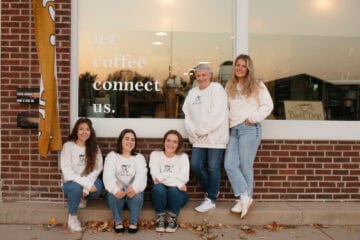 Shawano coffeehouse changes hands with former employee becoming owner
Shawano coffeehouse changes hands with former employee becoming owner Bull-ieve me – the rodeo is coming to West Central Wisconsin
Bull-ieve me – the rodeo is coming to West Central Wisconsin


